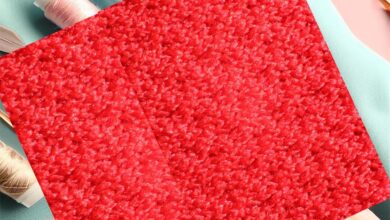How to Fray Fabric? Step-by-Step Guide (5 Best Techniques)

To fray fabric, trim the edges with scissors or rub the fabric against a hard surface like concrete until the threads start to unravel. Fraying fabric is a simple process that adds a distressed or vintage look to clothing, accessories, or home decor projects.
By following a few steps, you can achieve the desired frayed effect and customize your items without spending a lot of time or money.
Whether you want to give an old pair of jeans a new lease on life or add some texture to a plain cotton bag, fraying fabric is a fun and easy way to enhance your style.
Let’s dive into the details of how to fray fabric effectively.
What Is Fraying Fabric?
Fraying fabric refers to the process of unraveling or coming apart at the edges, resulting in loose threads or strands.
Frayed fabric adds a unique touch to clothing or home textiles, giving them a relaxed and textured appearance. It’s important to note that fraying can either be a desired effect or an unwanted consequence, depending on the desired outcome of the fabric.
Types Of Fabric Suitable For Fraying
Are you an avid crafter or fashion enthusiast looking to add a trendy touch to your projects? Fraying fabric can be a fantastic way to achieve that edgy, distressed look.
Before you embark on this creative journey, it’s essential to choose the right fabric for the best fraying results.
Here are some types of fabric that are suitable for fraying:
- Denim: As the epitome of casual cool, denim is perfect for fraying. Its sturdy weave can withstand the fraying process, resulting in stylishly frayed edges.
- Linen: Linen fabric has a natural texture that frays beautifully. Its loose weave allows for easy fraying, giving your craft a rustic and relaxed charm.
- Cotton muslin: Known for its smooth and lightweight nature, cotton muslin is a popular choice for fraying. Its fine weave frays evenly, creating delicate and wispy edges.
- Flannel: If you’re looking to add a cozy, worn-out touch to your projects, flannel fabric is an excellent option. Its soft and brushed surface frays effortlessly, lending a touch of warmth to your creations.
- Tweed: Tweed fabric adds a touch of sophistication to any design. Its intricate woven pattern frays elegantly, offering a unique look that combines texture and refinement.
Now that you have an idea of the fabric types suitable for fraying, you can confidently select the perfect material for your next project.
Remember to experiment with different fabrics and techniques to unleash your creativity and achieve the desired frayed effect.
How To Fray Fabric? Step-By-Step Guide

Fraying fabric is a technique used to create a textured, rugged edge on fabric. It’s commonly used for decorative purposes or to achieve a distressed or worn look in crafts, fashion, or home decor projects.
Here’s how you can fray fabric:
Select the Fabric:
Choose a fabric that frays well, such as denim, canvas, cotton, or linen. Synthetic fabrics may not fray as effectively.
Pre-Wash the Fabric:
Wash and dry the fabric before starting to fray. This helps to remove any sizing, soften the fibers, and prevent excessive shrinkage later.
Cut the Fabric:
Cut the fabric into the desired shape or size for your project. You can create frayed edges, patches, or even fringe.
Secure Edges (Optional):
If you want to control the fraying or prevent it from going too far, you can sew a straight stitch along the edge or use fabric glue to seal the edge. This step is optional and depends on the look you want to achieve.
Choose a Fraying Technique:
There are several methods to fray fabric edges. Certainly, Here are five different techniques you can use to fray fabric:
1. Scissor Fraying Technique:
- Lay the fabric flat on a clean surface.
- Using sharp fabric scissors, make small, vertical cuts along the edge of the fabric, about 1/8 to 1/4 inch apart. These cuts should be close to the edge but not all the way through.
- Gently pull the cut threads away from the fabric. The fabric’s edge will start to fray.
- Continue pulling the threads until you achieve the desired level of fraying.
- Optionally, wash and dry the fabric to enhance the fraying effect.
2. Wire Brush Fraying Technique:
- Lay the fabric on a flat surface.
- Use a wire brush with firm bristles or a pet brush to gently brush the edge of the fabric. Brush in the direction you want the fabric to fray.
- The brushing action will loosen and pull out the threads, creating a frayed edge.
- Continue brushing until you achieve the desired fraying effect.
- Shake off any loose threads or use a lint roller to clean up.
3. Seam Ripper Fraying Technique:
- Place the fabric on a flat surface.
- Use a seam ripper to carefully cut through the horizontal threads along the edge of the fabric.
- Once the horizontal threads are cut, gently pull the fabric to unravel the vertical threads, creating a frayed look.
- Repeat the process along the entire edge or as desired.
- Optionally, wash and dry the fabric to soften and enhance the fraying.
4. Washing Machine Fraying Technique:
- Place the fabric in a mesh laundry bag to prevent tangling.
- Wash the fabric in a washing machine using cold water and a gentle cycle.
- The agitation of the washing machine will encourage fraying along the edges of the fabric.
- After washing, remove the fabric from the laundry bag and gently pull apart any loosened threads for a more frayed look.
- Allow the fabric to air dry or use a dryer on a low heat setting.
5. Twisting and Snipping Fraying Technique:
- Lay the fabric flat on a clean surface.
- Make small snips along the edge of the fabric, about 1/8 to 1/4 inch apart.
- After making the snips, gently twist and pull the fabric to encourage fraying along the cut edges.
- Continue twisting and pulling until you achieve the desired fraying effect.
- Optionally, wash and dry the fabric to enhance the fraying and soften the edges.
Remember to practice on a scrap piece of fabric before working on your main project to get comfortable with each technique and adjust the intensity of fraying based on your preference.
Each technique offers a unique texture and appearance, so feel free to experiment and combine techniques for a more customized frayed effect.
Wash and Dry (Optional):
To enhance the fraying effect, you can wash and dry the fabric after you’ve frayed it. This will further loosen the threads and create a more natural frayed look. Place the fabric in a mesh laundry bag to prevent tangling during the washing machine cycle.
Trim Excess Threads (Optional):
After washing and drying, you might have some excess loose threads. Use scissors to trim these threads to achieve a neater frayed edge.
Incorporate into Your Project:
Use the frayed fabric in your project as desired. It can be used as an appliqué, patch, embellishment, or any creative way you envision.
Fraying fabric can be an artistic process that adds a unique touch to your creations. Experiment with different fraying techniques to achieve various degrees of frayed edges and distressed looks.
Remember, practice makes perfect, so don’t hesitate to try these techniques on scrap fabrics before working on your final project.
Embrace the frayed fashion trend with confidence and creativity.
For more details, watch the video.
Additional Tips And Tricks For Successful Fraying Fabric
Here are the tips and tricks for successful fabric fraying:
- Choose fray-prone fabrics like denim or cotton.
- Pre-wash fabric to remove sizing and prepare it for fraying.
- Practice on scrap fabric to perfect your technique.
- Use controlled cutting with scissors or rotary cutters.
- Angle cuts for a natural and textured fray.
- Apply fray check or fabric glue to prevent excessive unraveling.
- Experiment with freezing fabric or using tools like tweezers for control.
- Vary the lengths of frayed threads for a realistic look.
- Consider combining fraying with distressing techniques.
- Secure frayed edges with stitching if necessary.
- Enhance the effect by washing and drying after fraying.
- Incorporate frayed sections creatively into your project.
- Adapt these tips to your specific fabric and project needs.
Troubleshooting And Solutions
During the fabric fraying process, common issues may arise. Here are troubleshooting tips and solutions to address them:
Unwanted Unraveling: If your fabric unravels too quickly:
- Employ fabric glue, tape, or stitching to secure edges and control fraying.
- Opt for a less aggressive technique, like brushing with a wire brush, for controlled fraying.
Difficulty in Pulling Threads: If pulling threads is challenging:
- Pre-wash and soften fabric for easier manipulation.
- Enhance grip with tweezers for gentler thread extraction.
Uneven Fraying: For uneven fraying:
- Adjust technique and pressure, favoring a gentler approach in some areas.
- Regularly step back to ensure even progress.
Overly Aggressive Fraying: If fraying is excessive:
- Trim excess threads to maintain desired fraying level.
- Consider restarting with a controlled technique if needed.
Fabric Non-Responsiveness: For unresponsive fabric:
- Confirm fabric suitability (e.g., denim, canvas).
- Experiment with various techniques for better results.
Messy Threads: To manage loose threads:
- Work in ventilated spaces or outdoors.
- Employ sheets or cloths to catch falling threads.
Unintended Damage: If fabric tears accidentally:
- Embrace small tears as design elements.
- Trim or restart with new fabric for significant tears.
Remember, fabric fraying is a creative process where imperfections can enhance character. Practice on scraps before tackling main projects. Overcoming challenges through experimentation and practice ensures desired fraying outcomes.
Creative Ideas With Frayed Fabric
Frayed fabric adds a touch of rustic charm to any project or outfit. Whether you’re looking to upcycle an old pair of jeans or create a unique piece of home decor, fraying fabric is a fun and creative way to add texture and visual interest.
Here, we’ll explore some exciting ideas for incorporating frayed fabric into your projects.
- Frayed Denim Shorts: Update old denim shorts by fraying the edges and distressing them for a trendy, casual look.
- Boho Frayed Wall Hanging: Combine frayed fabric strips with wooden dowels to create a bohemian-inspired wall hanging for your living space.
- Frayed Edge Napkins: Make rustic and textured cloth napkins by fraying the edges of cotton or linen fabric squares.
- Frayed Fabric Jewelry: Craft fabric necklaces or bracelets by rolling and twisting frayed fabric strips. Add beads or charms for a unique accessory.
- Frayed Tote Bag Accents: Embellish plain tote bags by adding frayed fabric patches, stripes, or designs for a touch of character.
- Frayed Fabric Book Covers: Wrap books with frayed fabric covers to give them a cozy and worn-in appearance.
- Frayed Fabric Plant Pot Covers: Dress up potted plants by creating frayed fabric covers for the pots. These add a charming and textured element to your home decor.
These creative ideas offer just a glimpse into the endless possibilities of working with frayed fabric. Let your imagination run wild and incorporate frayed fabric into your next project to add a touch of uniqueness and character.
Have fun experimenting with different materials, colors, and textures to create stunning and one-of-a-kind creations.
Care And Maintenance Of Frayed Fabric

Caring for frayed fabric requires some special attention to maintain its appearance and prevent further unraveling. Here’s how to properly care for and maintain frayed fabric items:
Gentle Washing:
If your frayed fabric item is washable, use a gentle cycle and cold water to prevent excessive fraying and maintain the texture. Consider placing the item in a mesh laundry bag to protect it from tangling with other items.
Hand Washing:
For delicate frayed fabrics, consider hand washing in cold water using a mild detergent. Gently agitate the water and avoid wringing or twisting the fabric.
Avoid Harsh Detergents:
Use mild, gentle detergents to avoid weakening the fabric fibers. Harsh detergents can accelerate fraying and cause damage.
Separate Items:
Wash frayed fabric items separately from garments with zippers, hooks, or other sharp edges that might catch on the frayed threads.
Skip Fabric Softeners:
Fabric softeners can coat the fabric fibers and hinder their natural texture. Avoid using fabric softeners on frayed items.
Air Dry:
Hang or lay frayed fabric items flat to air dry. Avoid using a dryer, as the heat and agitation can worsen fraying and weaken the fabric.
Avoid Rough Surfaces:
When wearing or using frayed fabric items, be cautious around rough surfaces that could catch and pull on the threads, causing more fraying.
Spot Cleaning:
If only a small section needs cleaning, try spot cleaning using a mild detergent and a soft cloth. Blot gently, and avoid excessive rubbing.
Store Carefully:
Store frayed fabric items away from direct sunlight, as prolonged sun exposure can weaken fibers. If possible, store them in a cool, dry place.
Trim Loose Threads:
Periodically check for loose or overly frayed threads and trim them carefully with sharp scissors to prevent further unraveling.
Handle with Care:
When wearing or using frayed fabric items, handle them gently to prevent additional stress on the threads.
Follow Manufacturer’s Instructions:
Always follow any care instructions provided by the manufacturer for specific frayed fabric items.
Remember that frayed fabric items are more delicate due to their intentionally distressed nature. Taking proper care will help prolong the life of these items and maintain their unique appearance.
Final Thoughts
So, now you know how to fray fabric like a pro. With these simple steps and necessary precautions, you can achieve that trendy, frayed look for your clothing or home decor projects.
Remember to select the right fabric, use appropriate tools, and take your time with each step to ensure the best results.
Whether you’re aiming for a rustic, bohemian vibe or simply want to add some texture to your designs, fraying fabric is a versatile technique that can elevate your creativity.
Get ready to experiment with different fabrics and styles, and don’t be afraid to think outside the box.
Embrace the art of fraying fabric and enjoy the unique and personalized touch it can bring to your projects.
Happy fraying.
You can also read- How to Pre Wash Fabric Without Fraying?



